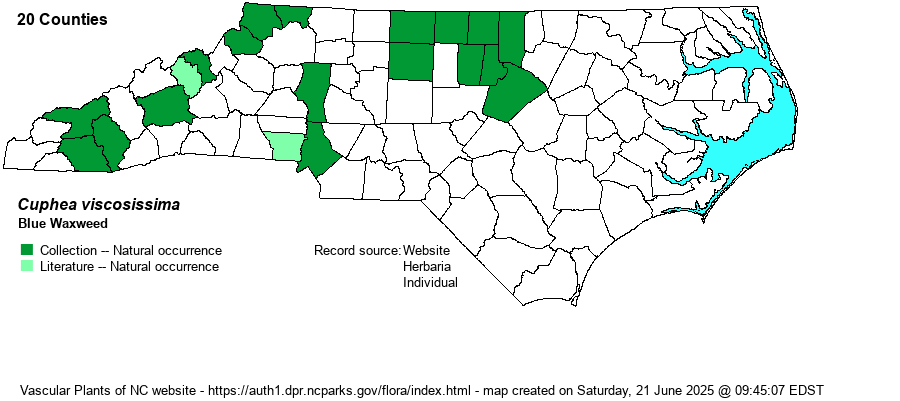| Author | Jacquin | |
| Distribution | Scattered across the northern Piedmont and the Mountains, with a few records south to Mecklenburg County.
This species has a narrow north-south range, but the range is broad east-west. It ranges from MA and southeastern NE, south only to NC, northern AL, and OK.
| |
| Abundance | Rare to uncommon in the Mountains and in the north-central Piedmont, close to the VA line. Extremely rare southward in the Piedmont. The species is much less numerous and widespread in NC than it is in neighboring VA, which is closer to the middle of the range. It is almost scarce enough to go onto a Watch List. | |
| Habitat | This is a species that requires high pH soil, over mainly mafic rocks. It favors sunny places, often in disturbed soil, but it can grow in damp ground or fairly dry ground as well. It grows in powerline clearings, weedy fields, roadsides, woodland borders, and other sunny places, rarely in natural habitats such as glades and barrens. | |
| Phenology | Blooms from July to October, and fruits shortly after flowering. | |
| Identification | This is an easily overlooked herb, with a simple stem to occasionally branched, reaching only about 9-12 inches tall. The stem(s) is quite hairy and has sticky hairs, as well. The opposite leaves are rather small, with a petiole that can reach about 3/4-inch long. The leaf blade is lanceolate to narrowly ovate, entire, about 1.5-2 inches long and about 1/4-inch wide. The flowers grow solitary or paired in upper leaf axils. Each has a slender floral tube, about 2/5-inch long, and the normally 6 petals -- 2 on top and 4 on the bottom -- "stick out" beyond the tube, spreading but narrow, and are purple in color; each petal is about 1/3-inch long. The floral tube in this species is purplish-green, versus green in the rather similar (but not native) C. carthagenensis. That exotic species is quite weedy, often growing in large patches in disturbed but almost always damp ground such as low-lying lawns; it has very short petioles, and the stamens are much shorter than the floral tube. C. viscosissima seldom grows in numbers where found, and often just a few plants can be found at any one site. Yet, despite it growing in disturbed sites (usually), it is a native species, worth a close look if and when you stumble onto it. | |
| Taxonomic Comments | A few old references named it as C. petiolata, though RAB (1968) did name it as C. viscosissima.
| |
| Other Common Name(s) | Clammy Cuphea, Tarweed | |
| State Rank | S3? [S2S3] | |
| Global Rank | G5? | |
| State Status | | |
| US Status | | |
| USACE-agcp | FAC link |
| USACE-emp | FAC link |

